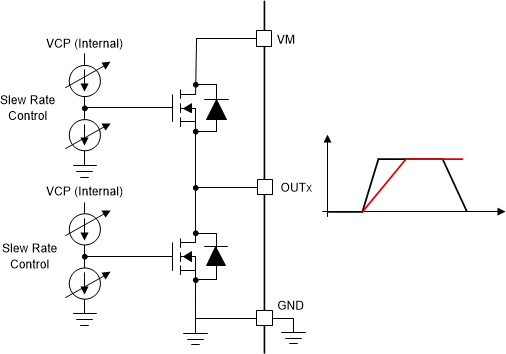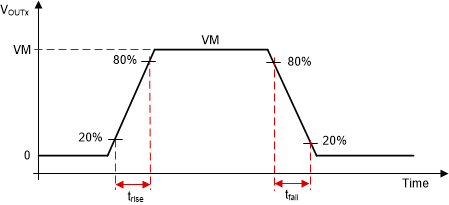ZHCSNP1A March 2021 – October 2021 MCT8316Z
PRODUCTION DATA
- 1 特性
- 2 应用
- 3 说明
- 4 Revision History
- 5 Device Comparison Table
- 6 Pin Configuration and Functions
- 7 Specifications
-
8 Detailed Description
- 8.1 Overview
- 8.2 Functional Block Diagram
- 8.3
Feature Description
- 8.3.1 Output Stage
- 8.3.2 PWM Control Mode (1x PWM Mode)
- 8.3.3 Device Interface Modes
- 8.3.4 Step-Down Mixed-Mode Buck Regulator
- 8.3.5 AVDD Linear Voltage Regulator
- 8.3.6 Charge Pump
- 8.3.7 Slew Rate Control
- 8.3.8 Cross Conduction (Dead Time)
- 8.3.9 Propagation Delay
- 8.3.10 Pin Diagrams
- 8.3.11 Active Demagnetization
- 8.3.12 Cycle-by-Cycle Current Limit
- 8.3.13 Hall Comparators (Analog Hall Inputs)
- 8.3.14 Advance Angle
- 8.3.15 FGOUT Signal
- 8.3.16
Protections
- 8.3.16.1 VM Supply Undervoltage Lockout (NPOR)
- 8.3.16.2 AVDD Undervoltage Lockout (AVDD_UV)
- 8.3.16.3 BUCK Undervoltage Lockout (BUCK_UV)
- 8.3.16.4 VCP Charge Pump Undervoltage Lockout (CPUV)
- 8.3.16.5 Overvoltage Protections (OV)
- 8.3.16.6 Overcurrent Protection (OCP)
- 8.3.16.7 Buck Overcurrent Protection
- 8.3.16.8 Motor Lock (MTR_LOCK)
- 8.3.16.9 Thermal Warning (OTW)
- 8.3.16.10 Thermal Shutdown (OTS)
- 8.4 Device Functional Modes
- 8.5 SPI Communication
- 8.6 Register Map
- 9 Application and Implementation
- 10Power Supply Recommendations
- 11Layout
- 12Device and Documentation Support
8.3.7 Slew Rate Control
An adjustable gate-drive current control to the MOSFETs of half-bridges is implemented to achieve the slew rate control. The MOSFET VDS slew rates are a critical factor for optimizing radiated emissions, energy and duration of diode recovery spikes, and switching voltage transients related to parasitics. These slew rates are predominantly determined by the rate of gate charge to internal MOSFETs as shown in Figure 8-16.
 Figure 8-16 Slew Rate Circuit Implementation
Figure 8-16 Slew Rate Circuit ImplementationThe slew rate of each half-bridge can be adjusted by the SLEW pin in hardware device variant or by using the SLEW bits in SPI device variant. Each half-bridge can be selected to either of a slew rate setting of 25-V/µs, 50-V/µs, 125-V/µs or 200-V/µs. The slew rate is calculated by the rise time and fall time of the voltage on OUTx pin as shown in Figure 8-17.
 Figure 8-17 Slew Rate Timings
Figure 8-17 Slew Rate Timings